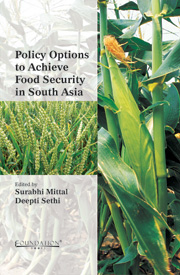Book contents
- Frontmatter
- Contents
- List of Contributors
- Foreword
- Acknowledgements
- List of Abbreviations
- 1 Food Security in South Asia
- 2 Food Security in India: Policies and Options
- 3 Multiple Facets of Food (In) Security in Sri Lanka: An Input to Food Policy
- 4 Food Security in Bangladesh: Achievements, Challenges and Way Forward
- 5 State of Agriculture and Food Security in Pakistan
- 6 Food Security Situation in Nepal: Issues and Suggested Policy Measures
- 7 Food Security in Maldives
- 8 Role of Regional Trade and Rural Development for Food Security in Bhutan
- 9 Food Security in Afghanistan
4 - Food Security in Bangladesh: Achievements, Challenges and Way Forward
Published online by Cambridge University Press: 05 June 2012
- Frontmatter
- Contents
- List of Contributors
- Foreword
- Acknowledgements
- List of Abbreviations
- 1 Food Security in South Asia
- 2 Food Security in India: Policies and Options
- 3 Multiple Facets of Food (In) Security in Sri Lanka: An Input to Food Policy
- 4 Food Security in Bangladesh: Achievements, Challenges and Way Forward
- 5 State of Agriculture and Food Security in Pakistan
- 6 Food Security Situation in Nepal: Issues and Suggested Policy Measures
- 7 Food Security in Maldives
- 8 Role of Regional Trade and Rural Development for Food Security in Bhutan
- 9 Food Security in Afghanistan
Summary
Introduction
Bangladesh is the seventh most populated country in the world with the population of 160 million in 2008 (WDI, 2009). In 2005, Bangladesh had the highest poverty rate in South Asia (40 per cent) with rural and urban poverty rate being 43.8 and 28.4 per cent, respectively (Food Security Statistics, 2009). The proportion of undernourishment is also highest in the country, 26 per cent with prevalence of undernourishment in total population, among all South Asian countries (Food Security Statistics, 2009). However, over time, Bangladesh has made remarkable progress in economic development and has improved its food security status. Per-capita GDP has increased from US$ 211 in 1973–74 to US$ 554 in 2007–08. Since the early 1990s, the country has been experiencing high rates of economic growth over 5 per cent per annum. Poverty rates have also declined from 75 per cent in 1973–74 to 40 per cent in 2005–06.
Since independence in 1971, the production and consumption of foodgrains has been increasing. Though, there were ups and downs, the production of foodgrains generally experienced an upward trend. In 2007–08, compared to 1970–71, the production of different food items has increased significantly. Production of foodgrains (rice and wheat) has increased by three times (from 9.99 million tons in 1972–73 to 29.78 million tons in 2007–08). During this period, the production of vegetables increased by 6.5 times, milk by five times (from about 0.49 million tons to 2.65 million tons) and meat production increased by four times (from 0.24 million tons to 1.04 million tons).
- Type
- Chapter
- Information
- Policy Options to Achieve Food Security in South Asia , pp. 77 - 105Publisher: Foundation BooksPrint publication year: 2011



